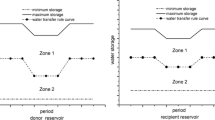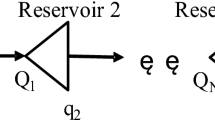Abstract
This study derives tri-level programming model for multi-reservoir optimal operation in inter-basin transfer-diversion-supply project. Considering the complexity, uncertainty and dynamic nature of the transfer-diversion-supply project, the tri-level programming model is explored in this study to deeply reveal the independency and Inter connectedness of Stackelberg’s decision among transfer, diversion and supply, which is denoted with a set of rule curves of donor reservoirs and recipient reservoirs. Except that the reservoir operation rule can be devised, the model also indicates that it’s possible to establish a greater sustainability. In order to verify the utility of the tri-level programming model, an inter-basin water transfer-diversion-supply project in China is used as a case study. A particle swarm optimization can be easily integrated with simulation models to improve the performance of non-linear optimization. But PSO has premature convergence. IEA has excellent global search performance. So, the IEA-PSO is adopted for optimizing the decision variables. The result shows that the suggested method can achieve operation goal effectively and also improve the operation performance of the inter-basin multi-reservoir system. This article highlights the superior results compared with the current operating control rules.








Similar content being viewed by others
References
American Water Works Association (AWWA (2002) Drought management handbook, American water works association, Denver, Colorado. application in reservoir system operation. Water Resour Manag 24:1107–1138
Chang J-X, Wang Y, Istanbulluoglu E, Bai T, Huang Q, Yang D, Huang S (2014) Impact of climate change and human activities on runoff in the Weihe River Basin, China. Quatern Int
Changye G, Yichao H (2013) Sequence water supply rule for reservoir operation based on bilevel programming. Chin Rural Water Reserv Electric Power 8:50–54
Chaves P, Kojiri T (2007) Deriving reservoir operational strategies considering water quantity and quality objectives by stochastic fuzzy neural networks. Adv Water Resour 30(5):1329–1341
Dariane AB, Sarani S (2013) Application of intelligent water drops algorithm in reservoir operation. Water Resour Manag 27:4827–4823
Dedi L, Shenglian G, Xiaohong C (2012) (2012). A macro-evolutionary multi-objective immune algorithm with application to optimal allocation of water resources in Dongjiang River basins, South China. Stoch Environ Res Risk Assess 26:491–507
Fang W, Wenlin Y (2010) Application of particle swarm optimization and immune evolutionary algorithm to optimal operation of cascade reservoirs. J Hydroelectric Eng 29(1):202–206,212
Guodong Q, Zhanghua L (2013) Application of particle swarm algorithm in the optimal allocation of regional water resources based on immune evolutionary algorithm. J Shanghai Jiaotong Univ 18(5):634–640
Hamid RS, Iman C, Abdolreza K-S et al (2013) Optimal reservoir operation based on conjunctive use of surface water and groundwater using neur-fuzzy systems. Water Resour Manag 27(10):4259–4275
Hu X, Eberhart R (2002) Multiobjective optimization using dynamic neighborhood particle swarm optimization. Congress Evol Comput Piscataway, New Jersey 2:1677–1681
Huicheng Z, Sha L (2013) Joint operation of water transfer-supply for the reservoir in intake area during inter-basin water transfer. J Hydraul Eng 44(8):883–891
Jianxia C, Tao B, Qiang H, Yang D (2013) Optimization of water resources utilization by by PSO-GA. Water Resour Manag 10:3525–3540
Jianxia C, Xuejiao M, ZongZhi W, Xuebin W, Qiang H (2014) Optimized cascade reservoir operation considering ice flood control and power generation. J Hydrol 519:1042–1051
Jianxia C, Yunyun L, Yimin W, Meng Y (2016) Copula-based drought risk assessment combined with an integrated index in the Wei River Basin, China. J Hydrol. doi:10.1016/j.jhydrol
Kefei L (2013) Study on methods of multi-objective decision making and risk analysis in reservoir operation. North China Electric Power University. Dissertation for the Doctoral Degree in Management Science
Labadie JW (2004) Optimal operation of multireservoir systems: state-of-the-art review. J Water Resour Plan Manag 130(2):93–111
Liu Y (2009) Automatic calibration of a rainfall-runoff model using a fast and elitist multi-objective particle swarm algorithm. Experts Syst Appl 36:9533–9538
Maass A, Hufschmidt MM (1962) Design of water resources system. Harvard University Press, Cambridge
Maoguo G, Chao L, Licheng J, Gang C (2010) Hybrid immune algorithm with Lamarckian local search for multi-objective optimization. Water Resour Manag 2(1):47–67
Pearson D, Walsh PD (1982) The derivation and use of control curves for the regional allocation of water resources. optimal allocation of water resources. Proc exeter Sym, lahs publ. NO. 135
Qiang L, Chunxi T (2011) Lessons from the management of inter-basin water transfer in the U.S. J Yangtze River Sci Res Instit 28(2):82–87
Rani D, Moreira MM (2010) Simulation-optimization modeling: a survey and potential
Safavi HR, Darzi F, Mariño MA (2010) Simulation-optimization modeling of conjunctive use of surface water and groundwater. Water Resour Manag 24:1965–1988
Shiau JT (2003) Water release policy effects on the shortage characteristics for the Shimen reservoir syetem during droughts. Water Resour Manag 17(6):463–480
Shiau JT, Lee HC (2005) Derivation of optimal hedging rules for a water-supply reservoir through compromise programming. Water Resour Manag 19:111–132
Thorne JM, Savic DA, Weston A (2003) Optimized conjunctive control rules for a system of water supply sources: roadford reservoir system (U.K.). Water Resour Manag 17:183–196
Tilmant A, Pinte D, Goor Q (2008) Assessing marginal water values in multipurpose multireservoir systems via stochastic programming. Water Resour Res 44(12). doi: 10.1029/2008wr007024
Vonk E, Xu YP, Booij MJ (2014) Adapting multi-reservoir operation to shifting patterns of water supply and demand. Water Resour Manag 28:625–643
Xiang Z, Tiesong H, Xunning G (2014) Water transfer triggering mechanism for multi-reservoir operation in inter-basin water transfer-supply project. Water Resour Manag 28:1293–1308
Xuning G, Tiesong H (2012) Multi-reservoir operating rule in inter-basin water trans-supply project. J Hydraul Eng 43(7):757–766
Yinshan X, Yadong M (2011) Operating rules of large-scale multi-reservoir system. J Hydroelectric Eng 30(2):20–25
Yu L, Peng Y (2015) Common tasks allocation problem of water supply for a complex multi-reservoir system. J Hydraul Eng 46(1):83–90
Acknowledgments
This research is supported by the Natural Sciences Foundation of China (51509089), China Postdoctoral Science Foundation (2015 M582205). The authors wish to express deep thanks to the anonymous reviewers for their review.
Author information
Authors and Affiliations
Corresponding author
Rights and permissions
About this article
Cite this article
Wan, F., Yuan, W. & Zhou, J. Derivation of Tri-level Programming Model for Multi-Reservoir Optimal Operation in Inter-Basin Transfer-Diversion-Supply Project. Water Resour Manage 31, 479–494 (2017). https://doi.org/10.1007/s11269-016-1540-2
Received:
Accepted:
Published:
Issue Date:
DOI: https://doi.org/10.1007/s11269-016-1540-2




